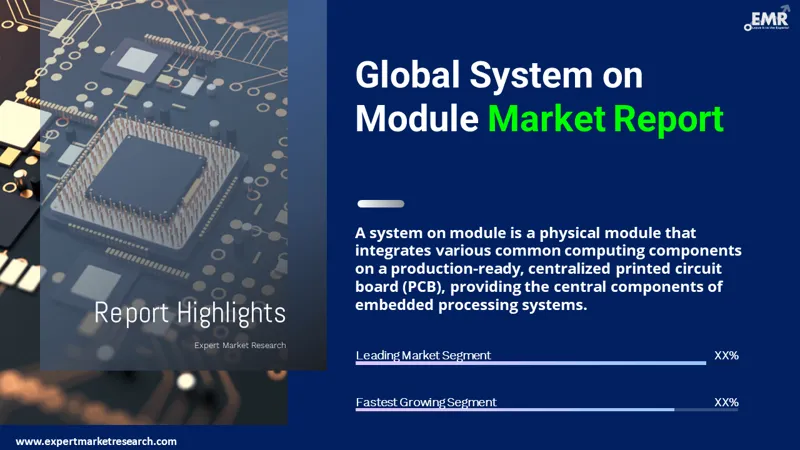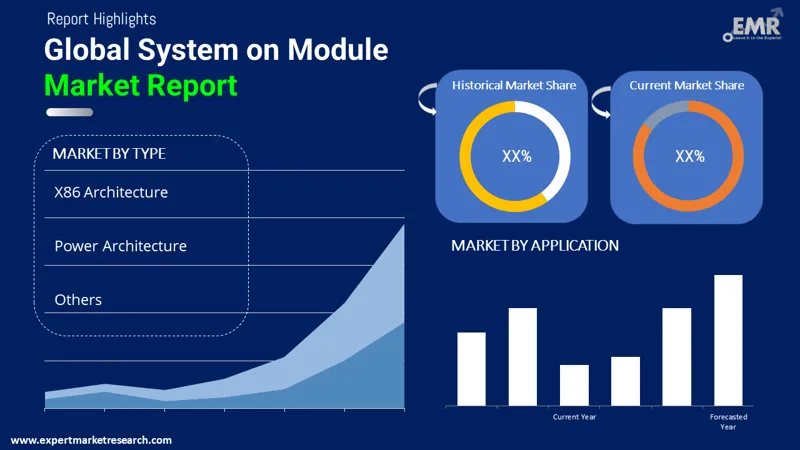
Consumer Insights
Uncover trends and behaviors shaping consumer choices today
Procurement Insights
Optimize your sourcing strategy with key market data
Industry Stats
Stay ahead with the latest trends and market analysis.
The global system on module market size reached a value of approximately USD 1.86 Billion in 2025. The market is expected to grow at a CAGR of 11.10% between 2026 and 2035, reaching a value of USD 5.33 Billion by 2035.
Base Year
Historical Period
Forecast Period
Compound Annual Growth Rate
11.1%
Value in USD Billion
2026-2035
*this image is indicative*
| Global System on Module Market Report Summary | Description | Value |
| Base Year | USD Billion | 2025 |
| Historical Period | USD Billion | 2019-2025 |
| Forecast Period | USD Billion | 2026-2035 |
| Market Size 2025 | USD Billion | 1.86 |
| Market Size 2035 | USD Billion | 5.33 |
| CAGR 2019-2025 | Percentage | XX% |
| CAGR 2026-2035 | Percentage | 11.10% |
| CAGR 2026-2035 - Market by Region | Asia Pacific | 14.4% |
| CAGR 2026-2035 - Market by Country | India | 16.5% |
| CAGR 2026-2035 - Market by Country | China | 13.8% |
| CAGR 2026-2035 - Market by Type | ARM Architecture | 12.2% |
| CAGR 2026-2035 - Market by Application | Automotive | 12.7% |
| Market Share by Country 2025 | Mexico | 1.5% |
System on module is a physical module that incorporates various common computing components, providing the central components of embedded processing systems on a centralised printed circuit board (PCB) that is production ready. Some of the common system on modules are CPU, flash memory, an Ethernet bus, Bluetooth radios, RAM, Wi-Fi, and power management units.

Read more about this report - REQUEST FREE SAMPLE COPY IN PDF

Read more about this report - REQUEST FREE SAMPLE COPY IN PDF
The EMR’s report titled “Global System on Module Market Report and Forecast 2026-2035” offers a detailed analysis of the market based on the following segments:
Market Breakup by Type
Market Breakup by Application
Market Breakup by Region
| CAGR 2026-2035 - Market by | Country |
| India | 16.5% |
| China | 13.8% |
| Brazil | 12.1% |
| Mexico | 10.3% |
| Australia | 9.8% |
| USA | XX% |
| Canada | XX% |
| UK | XX% |
| Germany | XX% |
| France | XX% |
| Italy | XX% |
| Japan | 8.6% |
| Saudi Arabia | XX% |
Power architecture type of system on module accounted for a significant share in the market as it offers high performance and processing power in comparison to other types of system on modules. They are highly scalable and reliable and hence are used in critical applications where failure can lead to severe consequences such as in aerospace and automotive industries, among others. Power architecture type of system on module are considered ideal for use in battery powered devices, among other applications as they consume comparatively less power.
Asia Pacific held a large share in the market for system on module and is expected to rapidly grow during the forecast period owing to the growing semiconductor manufacturing industry in the region. Technologies such as Internet of Things is penetrating the market in the region with industries and key end users increasingly adopting advanced and innovative technologies. Moreover, growing industrialisation in countries like India and China is further driving the market growth for system on modules.
The comprehensive EMR report provides an in-depth assessment of the market based on the Porter's five forces model along with giving a SWOT analysis. The report gives a detailed analysis of the following key players in the global system on module market, covering their competitive landscape and latest developments like mergers, acquisitions, investments and expansion plans.
VIA Technologies, Inc is a motherboard company that was founded in 1987 and is headquartered in New Taipei City, Taiwan. The company is known for manufacturing motherboard chipsets, memory, and control processing units, among others.
Toradex AG was established in 2003 and has its headquarters in Lucerne, Switzerland. This computer hardware manufacturing company provides easy-to-use embedded computing products that are of premium quality and have long term durability.
PHYTEC America LLC was founded in 1986 and is based in Washington in the United States. It focusses on providing embedded systems, ARM processor technology, and printed circuit board design, among other products.
*Please note that this is only a partial list; the complete list of key players is available in the full report. Additionally, the list of key players can be customized to better suit your needs.*
Other market players include TechNexion Ltd., SECO S.p.A., Microchip Technology Inc, Kontron AG, EMAC, Inc., AAEON Technology Inc., Connect Tech Inc, and Axiomtek Co., Ltd, among others.




*While we strive to always give you current and accurate information, the numbers depicted on the website are indicative and may differ from the actual numbers in the main report. At Expert Market Research, we aim to bring you the latest insights and trends in the market. Using our analyses and forecasts, stakeholders can understand the market dynamics, navigate challenges, and capitalize on opportunities to make data-driven strategic decisions.*
Get in touch with us for a customized solution tailored to your unique requirements and save upto 35%!
The global market for system on module reached a value of approximately USD 1.86 Billion in 2025.
The market is expected to grow at a CAGR of 11.10% between 2026 and 2035.
The market is estimated to witness a healthy growth in the forecast period of 2026-2035 to reach around USD 5.33 Billion by 2035.
The key drivers of the market include increasing production of electronics, rising demand from the automotive industry, and growing industrialisation.
The key trends of the market are increasing use of system on module in healthcare, reduced risk of error, and emerging technologies.
The primary types of system on module are ARM architecture, X86 architecture, and power architecture, among others.
The various applications of system on module in the market are automotive, chemical and petrochemical, energy and power, food and beverages, oil and gas, and healthcare, among others.
The key players in the global system on module market are VIA Technologies, Inc, Toradex AG, PHYTEC America LLC, TechNexion Ltd., SECO S.p.A., Microchip Technology Inc, Kontron AG, EMAC, Inc., AAEON Technology Inc., Connect Tech Inc, and Axiomtek Co., Ltd, among others.
Explore our key highlights of the report and gain a concise overview of key findings, trends, and actionable insights that will empower your strategic decisions.
| REPORT FEATURES | DETAILS |
| Base Year | 2025 |
| Historical Period | 2019-2025 |
| Forecast Period | 2026-2035 |
| Scope of the Report |
Historical and Forecast Trends, Industry Drivers and Constraints, Historical and Forecast Market Analysis by Segment:
|
| Breakup by Type |
|
| Breakup by Application |
|
| Breakup by Region |
|
| Market Dynamics |
|
| Competitive Landscape |
|
| Companies Covered |
|
Datasheet
One User
USD 2,499
USD 2,249
tax inclusive*
Single User License
One User
USD 3,999
USD 3,599
tax inclusive*
Five User License
Five User
USD 4,999
USD 4,249
tax inclusive*
Corporate License
Unlimited Users
USD 5,999
USD 5,099
tax inclusive*
*Please note that the prices mentioned below are starting prices for each bundle type. Kindly contact our team for further details.*
Flash Bundle
Small Business Bundle
Growth Bundle
Enterprise Bundle
*Please note that the prices mentioned below are starting prices for each bundle type. Kindly contact our team for further details.*
Flash Bundle
Number of Reports: 3
20%
tax inclusive*
Small Business Bundle
Number of Reports: 5
25%
tax inclusive*
Growth Bundle
Number of Reports: 8
30%
tax inclusive*
Enterprise Bundle
Number of Reports: 10
35%
tax inclusive*
How To Order

Select License Type
Choose the right license for your needs and access rights.

Click on ‘Buy Now’
Add the report to your cart with one click and proceed to register.

Select Mode of Payment
Choose a payment option for a secure checkout. You will be redirected accordingly.
Gain insights to stay ahead and seize opportunities.

Get insights & trends for a competitive edge.

Track prices with detailed trend reports.

Analyse trade data for supply chain insights.

Leverage cost reports for smart savings

Enhance supply chain with partnerships.

Connect For More Information
Our expert team of analysts will offer full support and resolve any queries regarding the report, before and after the purchase.
Our expert team of analysts will offer full support and resolve any queries regarding the report, before and after the purchase.
We employ meticulous research methods, blending advanced analytics and expert insights to deliver accurate, actionable industry intelligence, staying ahead of competitors.
Our skilled analysts offer unparalleled competitive advantage with detailed insights on current and emerging markets, ensuring your strategic edge.
We offer an in-depth yet simplified presentation of industry insights and analysis to meet your specific requirements effectively.
Share